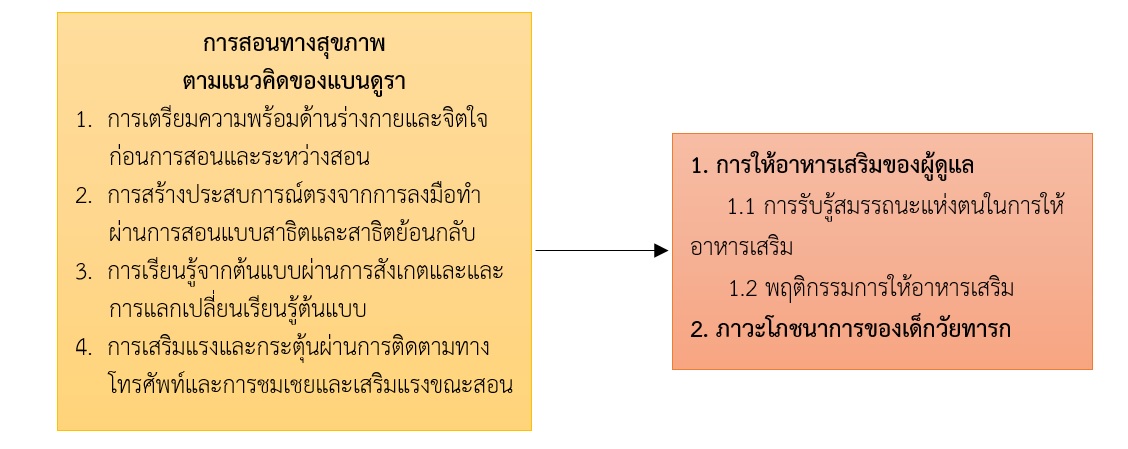ผลของการสอนทางสุขภาพตามแนวคิดของแบนดูราต่อการรับรู้สมรรถนะแห่งตน พฤติกรรมการให้อาหารเสริมของผู้ดูแลและภาวะโภชนาการของเด็กวัยทารก
คำสำคัญ:
ผู้ดูแล, เด็กวัยทารก, การสอนทางสุขภาพ, การให้อาหารเสริมบทคัดย่อ
การวิจัยแบบกึ่งทดลองแบบสุ่มเข้ากลุ่มทดลองและกลุ่มควบคุมแบบคู่ขนานนี้มีวัตถุประสงค์เพื่อศึกษาผลของการสอนทางสุขภาพตามแนวคิดของแบนดูราต่อการรับรู้สมรรถนะแห่งตน พฤติกรรมการให้อาหารเสริมของผู้ดูแล และภาวะโภชนาการเด็กวัยทารก กลุ่มตัวอย่าง คือ ผู้ดูแลและเด็กวัยทารกอายุ 6 เดือนที่เข้ารับบริการในคลินิกเด็กสุขภาพดี โรงพยาบาลส่งเสริมสุขภาพตำบลปะเหลียน อ.ปะเหลียน จ. ตรัง จำนวน 60 คู่ แบ่งเป็นกลุ่มทดลองและกลุ่มควบคุม กลุ่มละ 30 คู่ กลุ่มทดลองได้รับการให้ความรู้ทางสุขภาพตามแนวคิดของแบนดูราต่อการให้อาหารเสริม โดยมีการติดตามเยี่ยมบ้าน และการติดตามทางโทรศัพท์ ในขณะที่กลุ่มควบคุมได้รับการดูแลตามปกติตามสมุดบันทึกสุขภาพแม่และเด็ก เครื่องมือที่ใช้ในการในการเก็บรวบรวมข้อมูล คือ แบบสอบถามข้อมูลส่วนบุคคล การรับรู้สมรรถนะแห่งตนในการให้อาหารเสริมและพฤติกรรมการให้อาหารเสริมของผู้ดูแล และประเมินภาวะโภชนาการเด็กวัยทารก โดยแบบสอบถามการรับรู้สมรรถนะแห่งตนในการให้อาหารเสริม และพฤติกรรมการให้อาหารเสริม หาความตรงของเครื่องมือได้ค่า IOC ระหว่าง .67-1.00 และค่าความเที่ยงจากสูตรสัมประสิทธิ์แอลฟาของครอนบาค เท่ากับ .80, .86 การวิเคราะห์ข้อมูลโดยใช้สถิติพรรณนา สถิติ Independence t-test และ สถิติ Chi-Square ผลการวิจัยพบว่า
1. ไม่มีความแตกต่างของคะแนนเฉลี่ยการรับรู้สมรรถนะแห่งตนในการให้อาหารเสริมของกลุ่มทดลองและกลุ่มควบคุม
2. ค่าเฉลี่ยพฤติกรรมการให้อาหารเสริมในกลุ่มทดลองสูงกว่ากลุ่มควบคุม อย่างมีนัยสำคัญทางสถิติที่ระดับ .05
2. เด็กวัยทารกของกลุ่มทดลองมีภาวะโภชนาการอยู่ในเกณฑ์ปกติมากกว่าเด็กวัยทารกของกลุ่มควบคุมอย่างมีนัยสำคัญทางสถิติที่ระดับ .05
ดังนั้น รูปแบบการให้ความรู้ดังกล่าวควรนำไปประยุกต์ใช้ในการดูแลแม่และเด็กในชุมชน โดยมีพยาบาลชุมชนเป็นผู้สอนทางสุขภาพและอาสาสมัครสาธารณสุขเป็นผู้ติดตาม และควรดำเนินการอย่างต่อเนื่องไปจนเด็กอายุครบ 1 ปี
เอกสารอ้างอิง
Bandura, A. (1971). Social Learning Theory. Retrieved from http://www.asecib.ase.ro/mps/ Bandura_SocialLearningTheory.pdf.
Chan, M. Y., Ip, W. Y., & Choi, K. C. (2016). The Effect of a Self-Efficacy-Based Educational Program on Maternal Breastfeeding Self-Efficacy, Breast Feeding Duration and Exclusive Breast-Feeding Rates: A Longitudinal Study. Midwifery, 36, 92-98.
Dodt, R. C. M., Joventino, E. S., Aquino, P. S., Almeida, P. C., & Ximenes, L. B. (2015). An Experimental Study of an Educational Intervention to Promote Maternal Self-Efficacy in Breastfeeding. Revista Latino-Americana De Enfermagem, 23(4), 725-732.
Hendriyani, H., Sudargo T., Lusmilasari, L., Helmyati, S., Susetyowati, S., & Nindrea, R. D. (2020). Complementary Feeding Self-Efficacy: A Concept Analysis. Macedonian Journal of Medical Sciences, 15(8), 11-22.
Jintrawet, U., Sukkasem, N., Tongswas, T., & Somboon, L. (2015). Effects of Breastfeeding Promotion and Social Support Program on Breastfeeding Self-Efficacy and Exclusive Breastfeeding Rate among Postpartum Mothers. Journal of Nursing Science Chulalongkorn University, 27(2), 34-47. (In Thai).
Johnson, K. E., McMorris, B. J., Raynor, L. A., & Monsen, K. A. (2013). What Big Size You Have! Using Effect Sizes to Determine the Impact of Public Health Nursing Interventions. Applied Clinical Informatics, 4(3), 434–444. https://doi.org/10.4338/ACI-2013-07-RA-0044.
Kalid, M., Osman, F., Sulaiman, M., Dykes, F., & Erlandsson, K. (2019). Infant and Young Child Nutritional Status and Their Caregivers' Feeding Knowledge and Hygiene Practices in Internally Displaced Person Camps, Somalia. BMC Nutrition, 5, 59.
Khakhong, S., & Nirattharadorm, M. (2017). The effects of Promoting Self-Efficacy Program on Breast Feeding Behavior among Adolescent Mothers in Community. Journal of Public Health, 47(1), 31-43. (In Thai).
Krisame, K. (2020). Effects of Child Caregivers’ Self-Efficacy Enhancement Program for Promoting Child. Academic Journal of Mahasarakham Provincial Public Health Office, 4(8), 72-84. (In Thai).
Laving, A. R., Hussain, S. R., & Atieno, D. O. (2018). Overnutrition: Does Complementary Feeding Play a Role? Annuals of Nutrition & metabolism, 73(Suppl 1), 15-18.
Montigny, F., & Lacharité, C. (2005). Perceived Parental Efficacy: Concept Analysis. Journal of Advanced Nursing, 49(4), 387-396.
Munirul, I. M., Arafat, Y., Connell, N., Mothabbir, G., McGrath, M., Berkley, J. A., et al. (2019). Severe Malnutrition in Infants Aged < 6 Months-Outcomes and Risk Factors in Bangladesh: A Prospective Cohort Study. Maternal and Child Nutrition, 15(1), e12642.
Prell, C., & Koletzko, B. (2016). Breastfeeding and Complementary Feeding: Recommendations on Infant Nutrition. Deutsches Ärzteblatt International, 113(25), 435-444.
Qu, P., Mi, B., Wang, D., Zhang, R., Yang, J., Liu, D. et al. (2017). Association Between the Infant and Child Feeding Index (ICFI) and Nutritional Status of 6- to 35-Month-Old Children in Rural Western China. PloS One, 12(2), e0171984-e0171984.
Rafieyan-Kopaei, Z., Fathian-Dastgerdi, Z., Tarrahi, M. J., & Zamani-Alavijeh, F. (2019). Effectiveness of Message-Framing Intervention on Complementary Feeding Related Behaviors among Mothers with Infants Aged 4-8 Months: A 3-Arm Randomized Controlled Trial. Italian Journal of Pediatrics, 45(1), 158-158.
Saleem, A. F., Mahmud, S., Baig-Ansari, N., & Zaidi, A. K. M. (2014). Impact of Maternal Education about Complementary Feeding on Their Infants' Nutritional Outcomes in Low-and Middle-Income Households: A Community-Based Randomized Interventional Study in Karachi, Pakistan. Journal of Health, Population and Nutrition, 32(4), 623-633.
Trang Provincial Public Health Office. (2019). Population Report. Retrieved from https://trg. hdc.moph.go.th/hdc/reports/.
Vazir, S., Engle, P., Balakrishna, N., Griffiths, P. L., Johnson, S. L., Creed-Kanashiro, H. et al. (2013). Cluster-Randomized Trial on Complementary and Responsive Feeding Education to Caregivers Found Improved Dietary Intake, Growth and Development among Rural Indian Toddlers. Maternal and Child Nutrition, 9(1), 99-117.
Wells, J. C. K. (2018). The Capacity-Load Model of Non-Communicable Disease Risk: Understanding the Effects of Child Malnutrition, Ethnicity and the Social Determinants of Health. European Journal of Clinical Nutrition, 72(5), 688-697.
Winichagoon, P., & Damrongwongsir, O. (2020). Breastfeeding Situation, Facilitators and Obstacles, Policy and Program to Promote Breastfeeding in Thailand. Journal of Nutrition Association of Thailand, 55(1), 66-81.
World Health Organization. (2017). Guidance on Ending the Inappropriate Promotion of Foods for Infants and Young Children: Implementation Manual. Retrieved from http: //apps.who.int/iris/bitstream/handle/10665.

ดาวน์โหลด
เผยแพร่แล้ว
ฉบับ
ประเภทบทความ
สัญญาอนุญาต
1. บทความหรือข้อคิดเห็นใด ๆ ที่ปรากฏในวารสารเครือข่าย วิทยาลัยพยาบาลและการสาธารณสุขภาคใต้ ที่เป็นวรรณกรรมของผู้เขียน บรรณาธิการหรือเครือข่ายวิทยาลัยพยาบาลและวิทยาลัยการสาธารณสุขภาคใต้ ไม่จำเป็นต้องเห็นด้วย
2. บทความที่ได้รับการตีพิมพ์ถือเป็นลิขสิทธิ์ของ วารสารเครือข่ายวิทยาลัยพยาบาลและการสาธารณสุขภาคใต้







